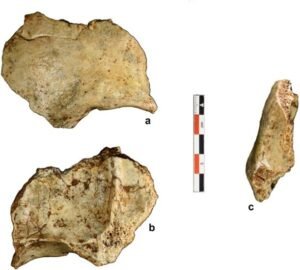Thousands of years prior to the rise of modern humans as the dominant species on Earth, they inhabited a mountain peak in Laos. However, it appears that their lineages eventually became extinct.
 The team at work in the cave. Credit: Kira Westaway
The team at work in the cave. Credit: Kira Westaway
Between 2009 and the present, a series of modern human fossils dating back 46,000 to 70,000 years have been uncovered in Tam Pà Ling (Cave of the Monkeys), a cave located in northeastern Laos.
Recently, Fabrice Demeter and his colleagues from the University of Copenhagen, Denmark, made a new addition to this collection, consisting of two additional fossils. These include a fragment of a human skull with delicate features and a piece of a leg bone.
Initially, the team mistook the skull fragment for a large stone, but upon closer inspection, they realized it was actually a white bone. After analyzing the fossil, it was determined to be a small fragment of a human skull.
 The skull bone found in Tam Pà Ling Cave. Credit: Fabrice Demeter/Freidline et al., Nature Communications, 2023
The skull bone found in Tam Pà Ling Cave. Credit: Fabrice Demeter/Freidline et al., Nature Communications, 2023 The tibia bone above, now the oldest discovered fossil from Tam Pà Ling Cave. Credit: Freidline et al., Nature Communications, 2023
The tibia bone above, now the oldest discovered fossil from Tam Pà Ling Cave. Credit: Freidline et al., Nature Communications, 2023
Although it is uncertain whether the two bones originated from the same individual, the researchers observed that the skull fragment displays characteristics of a slender or ‘gracile’ type of Homo sapiens.
Due to the protected status of the area where the fossils were discovered, the researchers were unable to directly determine their age.
To overcome this limitation, a team led by biological anthropologist Sarah Freidline from the University of Central Florida employed luminescence dating and other techniques to estimate the age of the sediment layers surrounding the newly found fossils.
The deepest fossil was located at a depth of approximately 7 meters (23 feet). To refine their age estimates, they utilized two bovid teeth found in close proximity to the fossils.
The results of their analysis support the previously estimated ages of the fossils discovered in Tam Pà Ling Cave. The skull fragment was determined to be between 67,000 and 73,000 years old, while the leg bone fragment belonged to an individual who lived approximately 68,000 to 86,000 years ago.
These findings indicate that modern humans may have inhabited Southeast Asia much earlier, between 68,000 and 86,000 years ago, than previously believed (around 50,000 years ago).
This supports the hypothesis that modern humans migrated out of Africa much earlier than previously thought, even if their migrations were unsuccessful.
According to Laura Shackelford, a co-author from the University of Illinois Urbana-Champaign, the existence of fossils dating back to nearly 80,000 years suggests the occurrence of multiple migrations out of Africa.
The fossils uncovered in Tam Pà Ling Cave may potentially belong to the ancestors of Indigenous Australians, whose remains found in Australia predate the previously estimated timeframe of 50,000 years.
However, there is limited knowledge regarding their exact origins, necessitating further research. Demeter emphasizes the need for additional investigation into this matter.
In the latest issue of the journal Nature Communications, the team report on the discovery of fossilized fragments from the site:
More information: Freidline, S.E., Westaway, K.E., Joannes-Boyau, R. et al. (2023). Early presence of Homo sapiens in Southeast Asia by 86–68 kyr at Tam Pà Ling, Northern Laos. Nat Commun 14, 3193.





